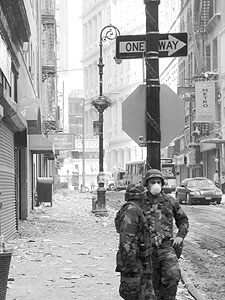![[Metroactive News&Issues]](/gifs/news468.gif)
[ San Jose | Metroactive Central | Archives ]
Photograph by Lauren Barack
Haunting Lessons
Former Metro writers send dispatches from the core of New York City
By Michael Learmonth and Lauren Barack
SEVEN BLOCKS from the World Trade Center towers, a terrible physics lesson still haunts us. Debris floats, but bodies fall. In the minutes after American Airlines Flight 11 and United Airlines Flight 77 pierced the exoskeleton of the towers, pieces of the plane and shards of the latticework began to fall away. From our roof we watched as the flames moved up floor by floor, and as people began to jump.
The fall from 90 stories takes sickeningly long. Long enough for an onlooker to gasp twice and let out a scream, an epithet, or a prayer. Arms and legs flail, but the lack of rigid edges means a human body in free fall can do little to alter its trajectory. They jumped in waves. Some held hands. Others jumped at the sight of a helicopter hovering helplessly hundreds of yards away.
It was hard to watch, but harder not to. One's mind refuses to accept the idea of giving up hope, but the people jumping had done just that. The terror of what we were watching swallowed us. In hindsight, it seems the jumpers chose well. The alternative would be to burn, be crushed or die slowly, pinned beneath mountains of debris.
Orange, red, gray and brown mixed into that spectacular blue September sky. Then the needle on the north tower began to sink, and a wall of dust charged over Manhattan, blotting out the sun and spreading inches, and in some places feet, of ash. It covered buildings, streets and cars. It leaked into our apartment through the cracks between the wooden window frames. It carried with it personal effects, clothing and the contents of in-boxes.
Scattered were pages of a Harlequin romance novel burned neatly around the edges, a blizzard of business cards and a memo on economic opportunities in Brazil. There were shoes, hats, printed email messages and a coffee cup. On a window someone wrote "Revenge" in the ash with a finger.
The two of us had moved to Manhattan just three months before. Both journalists, we left the Bay Area one year ago for a journey that would take us to London and then New York on a series of jobs and assignments. We moved into the South Street Seaport district right over the Fulton Fish Market. It's an area immortalized by New Yorker writer Joseph Mitchell and was once home to Herman Melville. Now we stood on the roof of our sixth-floor landmark building and watched in horror with neighbors whose names we still did not know.
The power went out late that first day when World Trade Center building 7, weakened by the inferno, collapsed. The phones died the next morning. We quickly accepted as part of the scenery National Guardsmen, police, firefighters, state troopers and FBI officers who walked the streets in quiet calm. And just as quickly, we found New Yorkers accustomed to keeping their guard up and knowing not to make eye contact suddenly shaking each other's hands. Neighbors exchanged names and cell phone numbers, shared calling cards and offered hot showers to those whose landlords didn't splurge for the $200-a-day generators. New York cops, long sneered at by the New York elite, found homemade chocolate chip cookies thrust in their hands.
"We're waiting for everyone to hate us again," said one officer stationed on our corner to guard during the unlit nights against looters. "But we'll take it while we can."
BY SUNDAY, it appeared the congeniality was running out. The smiles started to fade. The lack of sleep had taken over. A feeling of hopelessness had settled in. Even those desperate to help were being turned away. Their frustrations seeped into the city. FEMA began to complain of the "mini-crisis" being caused by the surplus of food and clothing. Volunteers arriving from all corners of the country were told to go home. Blood centers shut their doors.
Rescue was still the official word from City Hall, and yet recovery was on the tip of everyone's tongue.
Six days after the collapse, the noxious column of white smoke is beginning to subside. It's been replaced by the sickening smell of diesel belching from power generators on every block. Giuliani encouraged businesses to reopen downtown this week. But utilities company Con Edison encouraged owners to rent power generators. "They want us to do in six days what normally takes six months," said Artie, a Con Ed engineer who has taken up residence in the phalanx of trucks on our block. "This is a nice neighborhood. But once we're done here, I don't ever want to come back."
For the rest of us, our choices are less clear. The debris will be cleared, the papers picked up, the soot washed down the gutter into the sewers below.
But the gaping hole in the sky will remain. And so, probably, will we.
[ San Jose | Metroactive Central | Archives ]
Copyright © 2001 Metro Publishing Inc. Metroactive is affiliated with the Boulevards Network.
For more information about the San Jose/Silicon Valley area, visit sanjose.com.
![]()
 Guarded Hopes: Rescue was the watchword in the days following the attack, but as the death toll climbed, a feeling of hopelessness settled in.
Guarded Hopes: Rescue was the watchword in the days following the attack, but as the death toll climbed, a feeling of hopelessness settled in.
Editors Note: Former Metro writers Michael Learmonth and his wife, Lauren Barack, live blocks away from the destroyed World Trade Center, where they witnessed the aftermath of the Sept. 11 attacks. They have been without power and phone service and must cross a police line to get to their apartment. They are filing these weekly reports to Metro.
From the September 20-26, 2001 issue of Metro, Silicon Valley's Weekly Newspaper.